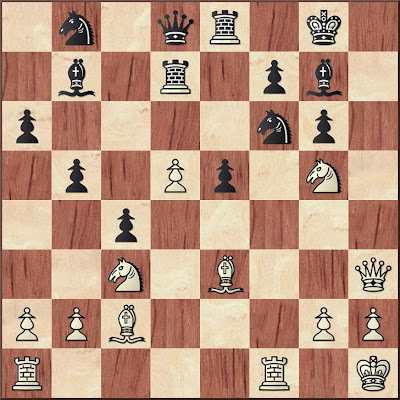Several days after the City Championship, my hard drive crashed. Some of the lost data includes the spreadsheet that I use to track my tactics training.
Despite these traumas, I maintained good focus on training and met most of my goals.
1. In 2013, I will solve correctly 300 tactics problems each month.
I correctly solved more than 250 problems before the City Championship in the middle of the month. Although the exact number is not available, I solved quite a bit more than 50 during the last two weeks of the month.
Before the City Championship, I actively used Tactic Trainer on the iPad, Chess Quest (iPad), and Alburt's Chess Training Pocket Book. I had a couple of sessions each on Chess.com, Chess Tempo, and Anthology of Chess Combinations. After the match, I continued with Chess Quest (iPad, and now also iPhone), Chessimo, and Shredder, and Tactic Trainer (iPad). The Chess Quest problems are getting harder on the iPad (level 4). On the iPhone, I am starting fresh at level 1, so I will be repeating previously solved problems.
I cannot say enough in praise of tactics training resources that are available for mobile devices. Whether the platform is iOS, Android, or some other, the available resources are extensive. For the past three years, I have rarely been anywhere without my iPad. One of my training sessions in early July lasted three hours. I rose well before my wife and in-laws one morning during the week that we spent at our cabin. I started solving problems with Tactic Trainer while still laying in bed. I continued after rising to make coffee and feed the dogs. Over the course of three hours, I correctly solved about 100 problems. Yesterday, standing in line to license my cat for another year, I solved four Chess Quest problems on the iPhone.
2. In 2013, I will study whole games and whole books.
I did not advance further through Max Euwe, The Development of Chess Style (1968) in July. However, I am nearly finished with Logical Chess: Move by Move. Much of the work that I did on Gioachino Greco, Andre Philidor, and other early masters in May was lost when my hard drive crashed (about 15% of this work was backed up). I have started anew on Greco. This time I am beginning with Francis Beale's 1656 edition of Greco's games (see "The Fooles Mate"). I am through the first 28 of the 94 games in that book (plus the illustrations of Fool's Mate and Scholar's Mate).
In the past few days, after reinstalling my chess software on my notebook computer with its new hard drive, I have been going through C67 in the Encyclopedia of Chess Openings. Playing through each line and its variations is time consuming, and C67 has many lines. Nonetheless, in each line, I am choosing at least one reference game and going through the whole in more detail. Yesterday's post resulted from this study (see "Pillsbury -- Lasker, St. Petersburg 1895").
Caruana -- Adams played last week is another C67 game that I spent some time with. At the currently running Dortmund Tournament, Michael Adams has won with both White and Black in this opening. With White he beat Dmitri Andrejkin in round 2. Andrejkin finished the strong Tal Memorial last month without a loss. With Black, he won an interesting game against Fabiano Caruana in round 3. I looked through both games, but spent quite a bit more time with the latter.
My study of whole games and whole books has come to characterize the time that I spend on chess!
Progress studying Dvoretsky's Endgame Manual did not go forward in July.
4. In 2013, I will lose fifteen pounds.
In July, I lost the weight gained in June. I do some exercise every day--walking a dog, playing tug-of-war with both dogs, or boxing on the Wii.
















































